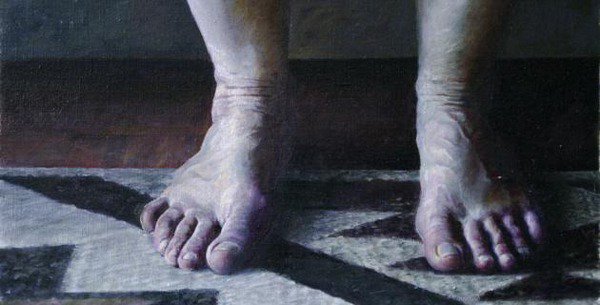Andries Gouws + Grace Kotze
dal 5/3/2012 al 24/3/2012
Segnalato da
5/3/2012
Andries Gouws + Grace Kotze
Kznsa Gallery, Durban
Gouws's 'Pedestrian Paintings' combines the interiors and still-lifes known from Gouws' previous shows with a series of paintings of feet on which he has been working since 2006. Kotze's 'thaw' presents a new body of work explores the expressive power of human posture.

Andries Gouws
Pedestrian Paintings
Main Gallery
Pedestrian Paintings (2006-2011), Andries Gouws’s travelling exhibition combines the interiors and still-lifes known from Gouws’ previous shows with a series of paintings of feet on which he has been working since 2006.
Living in Holland for 16 years after studying art in Cape Town (at Michaelis), Italy, Düsseldorf and finally Amsterdam, he started off painting “big, colourful, gestural abstract” paintings in acrylics before moving on to graphics.
In Holland he missed the South African landscape. On his return, having sold his treasured 500 kg Artel etching press and returned to oils, he hoped to paint the yearned for landscape, as well as the nude figure – subjects which “grabbed my gut most directly”.
Surprisingly though, he started painting interiors and still-lifes, unexpectedly connecting with a Dutch tradition that while in Holland he had felt he did not belong to.
Arguably, his feet paintings remain in the tradition of interiors and still-lifes, but possibly with an different intensity.
“These feet do not have the same meditative quality as my still lifes and interiors. They are more confrontational; engaging with feet disconcerts me – they look back at me in a way objects in a still life or interior don’t.”
His earlier work, he says, “often suggested that Vermeer and Piero were the artists I had looked at closely”. The current paintings “suggest other triggers: El Greco; Grünewald, Caravaggio even”. For his wife, the novelist and artist Ingrid Winterbach, his paintings of feet have a “Baroque religiosity”. Though he is an unbeliever, the echoes of Baroque religious painting in his rendering of feet shouldn’t be that surprising, given his expressed admiration for Velasquez and Rubens.
Young, pretty feet are not the subject of Gouws’s focus – he does not conceal/hide the battering that his subject matter has endured. A clue to his choice of rendering the most abused parts of the body in the rich texture of oils lies in his description of his immediate Durban environment as an area comprising “attractively ugly industrial areas”.
-----
Grace Kotze
thaw
Mezzanine Gallery
This new body of work explores the expressive power of human posture.
This new body of work explores the expressive power of human posture. I have chosen to limit my ‘verb’ base of gestures to gain deeper understanding of a specific set of emotions. This economy of range enables me to highlight how emotions are carried by the subtlest of posturing.
These works refer to a period of my life that was one of introspection, withdrawal and discovery, of which the majority were executed while in this state. Underlying that period was a new found strength that carried great sorrow but also celebrated life and the sense of self.
I found the most direct way to deal with such issues was through my own body. This enabled me to have more control over the postures during the photographing of the reference material. As I moved from one position to the next I was very aware of the emotional tugs each gesture carried. Then during the painting of the works I was able to revisit those positions and the appropriate triggers, which would come into play. As autobiographical as this may sound I see these works as social comments, emotional states that are indicative of human nature.
The other ‘subject’ in this exhibition is that of my love affair with paint. Within each brush mark, each line, each glaze etc. is a potential emotion. As with my quest to listen with acute awareness to the emotional vocabulary of a posture so are my concerns with the painterly application of pigment and medium. I endeavoured to paint each work in a manner that echoed the emotional tugs of the figure. This led to tonal changes, some areas of the body being highlighted with varied attention to detail, mark application, colour choices and varying thickness of paint.
The relationship between the emotional and physical construction of the body, with paint as a tool of exploration is a growing concern of mine. I am fascinated by the co-habitation of the emotional and physical under the guise of the human. One does not exist in isolation. This co-existence provides the most fertile fodder for the artist, which I am only starting to understand.
Opening 6 march 6pm
KZNSA - KwaZulu Natal Society of Arts
166 Bulwer Road, Glenwood, Durban
Admission free



